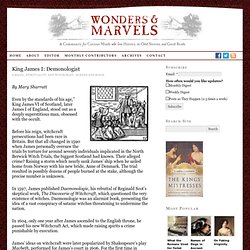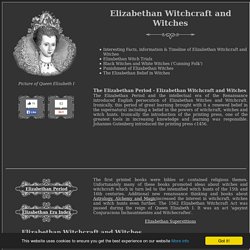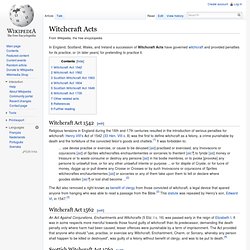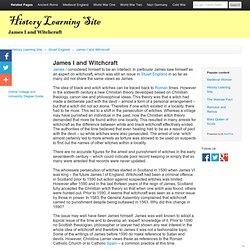

King James I: Demonologist. By Mary Sharratt Even by the standards of his age,” King James VI of Scotland, later James I of England, stood out as a deeply superstitious man, obsessed with the occult.

Before his reign, witchcraft persecutions had been rare in Britain. But that all changed in 1590 when James personally oversaw the trials by torture for around seventy individuals implicated in the North Berwick Witch Trials, the biggest Scotland had known. Their alleged crime? Raising a storm which nearly sank James’ ship when he sailed home from Norway with his new bride, Anne of Denmark. In 1597, James published Daemonologie, his rebuttal of Reginald Scot’s skeptical work, The Discoverie of Witchcraft, which questioned the very existence of witches.
In 1604, only one year after James ascended to the English throne, he passed his new Witchcraft Act, which made raising spirits a crime punishable by execution. James’s legacy extends even into our age. Further reading: Congratulations to the following winners: Elizabethan Witchcraft and Witches. Elizabethan Superstitions Who were the people accused of being Elizabethan Witches?

Women were those most often accused of being witches. There were 270 Elizabethan witch trials of 247 were women and only 23 were men. Those accused of witchcraft were generally: OldPoorUnprotectedSingle women or widows (many kept pets for company - their 'familiars') During the Elizabethan era men were all-powerful. Queen Elizabeth and the Punishment of Elizabethan WitchesThe hysteria and paranoia regarding witches which was experienced in Europe did not fully extend to England during the Elizabethan era.
Elizabethan Witches - Black Witches and White Witches ('Cunning Folk' or Healers)Up to the Renaissance period the wisdom of the 'Wise women' or 'Cunning Folk' - the White Witches - were seen as helpful, if not invaluable, members of the community. Witchcraft Acts. In England, Scotland, Wales, and Ireland a succession of Witchcraft Acts have governed witchcraft and provided penalties for its practice, or (in later years) for pretending to practice it.

Witchcraft Act 1542[edit] Religious tensions in England during the 16th and 17th centuries resulted in the introduction of serious penalties for witchcraft. Henry VIII's Act of 1542 (33 Hen. VIII c. 8) was the first to define witchcraft as a felony, a crime punishable by death and the forfeiture of the convicted felon's goods and chattels.[1] It was forbidden to: ... use devise practise or exercise, or cause to be devysed [sic] practised or exercised, any Invovacons or cojuracons [sic] of Sprites witchecraftes enchauntementes or sorceries to thentent [sic?]
Witchcraft Act 1562[edit] An Act Against Conjurations, Enchantments and Witchcrafts (5 Eliz. James I and Witchcraft. James I considered himself to be an intellect.

In particular James saw himself as an expert on witchcraft, which was still an issue in Stuart England in so far as many did not share the same views as James. The idea of black and witch witches can be traced back to Roman times. However in the sixteenth century a new Christian theory developed based on Christian theology, canon law and philosophical ideas. This theory was that a witch had made a deliberate pact with the devil – almost a form of a personal arrangement – but that a witch did not act alone. Therefore if one witch existed in a locality, there had to be more. There are no accurate figures for the arrest and punishment of witches in the early seventeenth century – which could indicate poor record keeping or simply that so many were arrested that records were never updated. Witchcraft. Search Results. Macbeth: Act II scenes 1-2 lesson plans: English Literature lesson plans: SAT Key Stage 3 lesson plans: Secondary school lessons: Schoolsnet. Home / Lessons / Secondary Lessons / SAT Key Stage 3 English Literature Key Stage 3: Macbeth: Act II scenes 1-2 Levels: 5-7 Reference Historical setting When Shakespeare wrote Macbeth, King James I had recently become King of England.

James was Scottish. King James believed in the Divine Right of Kings - that kings were chosen by God. James was also very interested in witchcraft. Locations in Macbeth Macbeth is often referred to as the 'Scottish play', since it is set in Scotland. The characters in Act II scenes 1-2 Macbeth Macbeth is the play's tragic hero, even though he commits terrible crimes. Lady Macbeth Lady Macbeth is a loyal and supportive wife. Banquo Banquo is a good man. Fleance We know little about Fleance - only that he is polite to his father and allowed to stay up late!
The story of Macbeth The following time line shows the main events that take place in Macbeth. Glossary image word picture used to bring an idea to life Thane of Cawdor A thane was a minor Scottish lord. Macbeth. Stop us if you've heard this one before: a man hears an exciting prophecy about his future and decides to take fate into his own hand by killing his king. Things go rapidly downhill. Sure, it's possible that you were just tra-la-la-ing through the Internet and randomly stumbled over this guide, but we're guessing that you already know Macbeth's basic plot.
After all, it is one of the most famous works of English literature, and it's even loosely based on some real-life 11th century events found in Holinshed's Chronicles. So let's tell you something you might not know: when it was first performed by Shakespeare's company around 1606, Macbeth was the latest in ripped-from-the-headlines, up-to-the-minute political events. It's basically The Dark Knight trilogy of the (very) early 17th century.
. (1) It was written in 1605 or 1606, right after James I, the first Stuart king, took up the crown of England in 1603. Coincidentally, Macbeth begins with the stage directions, "Enter three witches. "